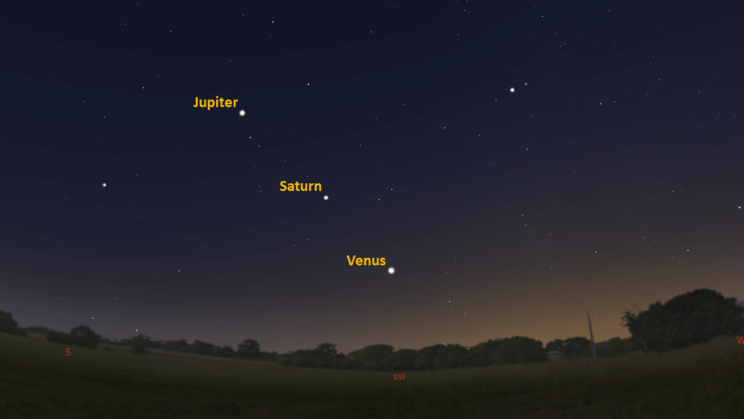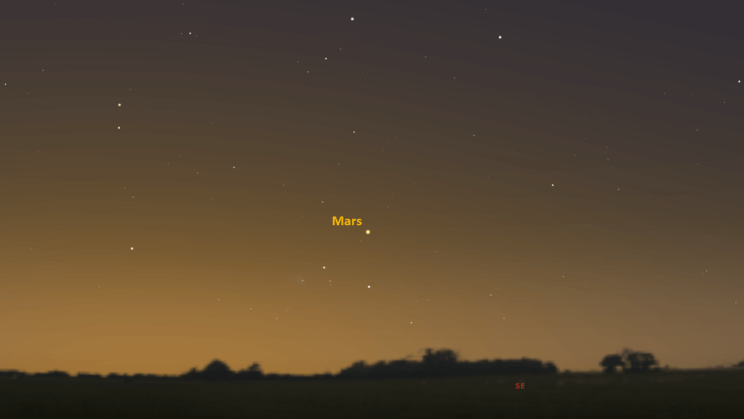This is the Saint Louis Science Center’s NIGHT SKY UPDATE for the week of Friday, December 10, 2021.
Information updated weekly or as needed.
Times given as local St. Louis time which is Central Standard Time (CST). For definitions of terminology used in the night sky update, click the highlighted text. If relying on times posted in Universal Time (UT), St. louis is -6 hours when CST.
Public Telescope Viewings
With the changing recommendations from the CDC regarding COVID-19, conversations regarding the return of star parties at the Saint Louis Science Center have begun. We are close to bringing back our public telescope viewings, but a few details still need to be worked out. We will post future updates as we learn more about when we can bring back telescope viewings.
Observing Highlight of the Week

Position of Geminid radiant at culmination around 2:30 am on December 14. The image also shows other meteor showers that are active. Image created using Stellarium.
The 2021 Geminid Meteor Shower is upon us. Often called shooting stars, meteors are space debris entering Earth’s atmosphere. Every year starting around November 19 and lasting through December 24, Earth enters a stream of debris from the asteroid 3200 Phaethon. As this debris enters Earth’s atmosphere, our skies are periodically lit up with streaks of light that signal the demise of that debris. If large enough, a meteor can become so bright its light will briefly cast shadows.
Meteor showers are annual events that are normally caused by comets. If a comet’s orbit is close enough to Earth, the debris it leaves behind will intersect Earth’s orbit producing an annual meteor shower. The Geminids are one of a few meteor showers not caused by a comet but rather is caused by an asteroid. Recently, scientists may have figured out how an asteroid can produce the debris associated with meteors. It is thought that perhaps sodium vaporizing in the asteroid could cause outgassing events that release the debris. You can learn more about this research at https://www.jpl.nasa.gov/news/fizzing-sodium-could-explain-asteroid-phaethons-cometlike-activity
Most meteor showers last several weeks but they do exhibit peak behavior. The peak date of the Geminids usually occurs on December 13/14 which is true for 2021. From a dark location, the Geminids are known to produce roughly 150 meteors per hour at peak times. This is provided you are viewing away from light pollution and the moon phase is near new moon. The Geminids are one of the best meteor showers each year.
Observing meteor showers is simple. First, find a dark location and grab a chair that reclines. Next, locate the radiant of the meteor shower. The radiant is the location in the sky that meteors appear to emanate from. The reason a radiant occurs is the same reason why when driving in a snowstorm, snowflakes appear to come from a point in front of you. As the Earth moves through a stream of debris, the particles are traveling in parallel pathways. This causes them to appear to converge at a point in front of the direction Earth is traveling. The radiant of a meteor shower is not the only place you see meteors; it is just something to be aware of. Knowing where the radiant is informs where you see meteors come from. If the radiant is low to the horizon, you will see meteors from that direction. If it is overhead, meteors will be seen in all direction moving away from the radiant. On December 13, the Geminid radiant is rising by 7:00 p.m. and it will culminate around 2:00 a.m.
So, what is the outlook for the 2021 Geminids? This year, the big problem will be the Moon. On the 13th, the Moon will be 78% full exhibiting a waxing gibbous phase. This is not good for meteor observing. There is a window after the Moon sets around 3:00 a.m. that skies will be a bit darker. Due to this your best bet to see the Geminids will be during early morning hours of December 14, 2021. If 2:00 a.m. to sunrise does not appeal to your sleep schedule, you will be able to see limited meteors in the early evening once the Geminid radiant clears the trees. For early evening views it will be best to look northeast.
If weather conditions do not permit clear views of the sky, there is another way to observe meteors. Radio telescope can be used to detect when a meteor enters the atmosphere. Most people are unaware that they already own a radio telescope of sorts. If you have a normal radio, that is in essence a radio telescope. If this interests you, I recommend exploring these radio meteor links.
https://www.rasc.ca/sites/default/files/RadioAstronomy_NovaNotes.pdf
http://mercury.pr.erau.edu/~prcphysics/observatory/meteors.htm
https://amsmeteors.org/ams-programs/radio-observing/
The Sun and Moon

The Moon as seen from the International Space Station, on July 31, 2011.
Credit: NASA
Sunrise is at 7:08 a.m. on Friday, December 10 and sunset is at 4:39 p.m. providing us with roughly 9.5 hours of daylight. Even after sunset, the light from the Sun will dimly illuminate our sky for roughly 1 hour and 30 minutes. This period is called twilight, which ends around 6:15 p.m. this week. For those with a sundial, local noon occurs around 11:53 a.m. this week.
| Day | Sunrise | Sunset |
|---|---|---|
| 2021-12-10 | 7:08 a.m. | 4:39 p.m. |
| 2021-12-11 | 7:09 a.m. | 4:40 p.m. |
| 2021-12-12 | 7:09 a.m. | 4:40 p.m. |
| 2021-12-13 | 7:10 a.m. | 4:40 p.m. |
| 2021-12-14 | 7:11 a.m. | 4:40 p.m. |
| 2021-12-15 | 7:12 a.m. | 4:41 p.m. |
| 2021-12-16 | 7:12 a.m. | 4:41 p.m. |
| 2021-12-17 | 7:13 a.m. | 4:41 p.m. |
| 2021-12-18 | 7:13 a.m. | 4:42 p.m. |
Moon
Moonrise for Friday, December 10 occurs at 12:31 p.m. and moonset will occur at 23:51 p.m. On Friday, December 10 the Moon will exhibit a first quarter phase. Full moon for December occurs on December 18, 2021.
International Space Station (ISS) Observing

Visible passes of ISS from St. Louis for the week of December 10 occur during morning hours. The best pass this week occur on the morning of December 18. Use the table below for information about this and other visible passes this week.
Catch ISS from St. Louis starting Friday, December 10
| Date | Starts | Max. altitude | Ends | |||||||
|---|---|---|---|---|---|---|---|---|---|---|
| Time | Alt. | Az. | Time | Alt. | Az. | Time | Alt. | Az. | ||
| 18 Dec | -1.7 | 06:05:29 | 10 | SSW | 06:08:28 | 30 | SE | 06:11:29 | 10 | ENE |
| 19 Dec | -0.8 | 05:18:54 | 10 | S | 05:21:12 | 17 | SE | 05:23:30 | 10 | E |
Magnitude (Mag): The Measure of brightness for a celestial object. The lower the value is, the brighter the object will be.
Altitude (Alt): The angle of a celestial object measured upwards from the observer’s horizon.
Azimuth (Az): The direction of a celestial object, measured clockwise from an observer’s location with north being 0°, east being 90°, south being 180° and west being 270°.
For information about ISS flyovers and other visible satellites, visit www.heavens-above.com
Detailed information regarding all unmanned exploration of our universe, missions past, present, and planned, can be found at Jet Propulsion Laboratories:
The Visible Planets

Looking South, at 5:30 p.m. December 12, 2021. Credit: Stellarium, EG

Looking east, at 6:26 am, December 13, 2021. Credit: Stellarium, EG
This week, four naked eye planets are visible. Venus can be found in the south southwest after sunset. Jupiter and Saturn can be found in the south after sunset. Mars is still tough to see but it is steadily climbing out of the Sun’s glare in the east before sunrise.
Venus
Venus is nearing the end of another evening apparition. It will be visible in the southwest as the sun sets. Venus will set at 7:07 p.m. Venus is on its way back towards the Sun’s glare as it approaches inferior conjunction on January 8, 2022. Venus is now bright enough to be seen naked eye during the day. If you have never attempted to spot Venus in the day, near sunset is the time to begin. As always, use precaution when trying to find something in the day as the Sun will be in the sky. Remember to never look directly at the Sun.
Mars
A new apparition for Mars has begun. Mars is becoming visible before sunrise. Look for the Red Planet 9° above the eastern horizon around 6:26 a.m. Mars will continue to climb out of the Sun’s glare as we see the end of 2021. Mars reaches opposition next year on December 7, 2022.
Jupiter
Jupiter has passed opposition and as such will be visible after sunset. Look for Jupiter in the south as it starts to darken outside. Jupiter sets at 9:46 p.m. and will set about 30 minutes earlier each week. Jupiter reaches superior conjunction on March 5, 2022. This means we can count on seeing Jupiter in the southern skies for the rest of this year and well into 2022.
Saturn
Saturn is past opposition which means it will be visible about 20 minutes after sunset. Right now, it can be found in the south after sunset, but as we continue through the year, Saturn will set about 30 minutes earlier each night. Saturn sets at 8:20 p.m. Saturn will reach superior conjunction on February 4, 2022.
James S. McDonnell Planetarium
Night Sky Update: December 10 – December 18, 2021






